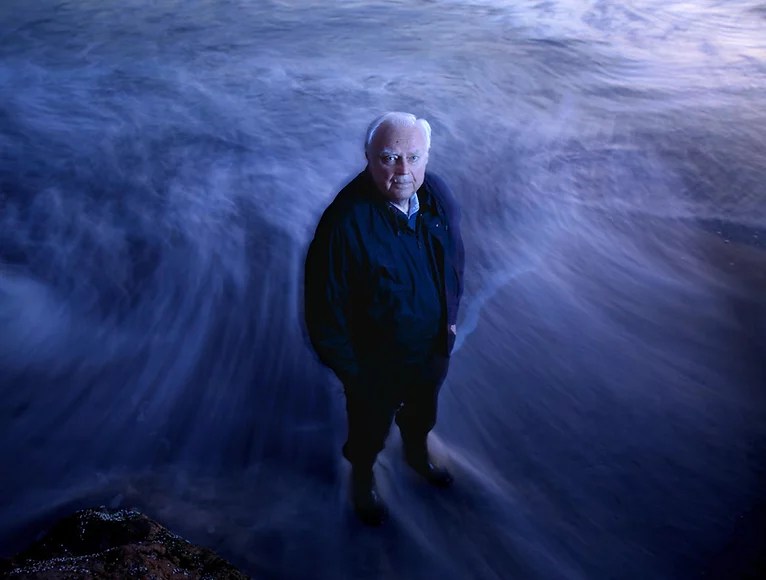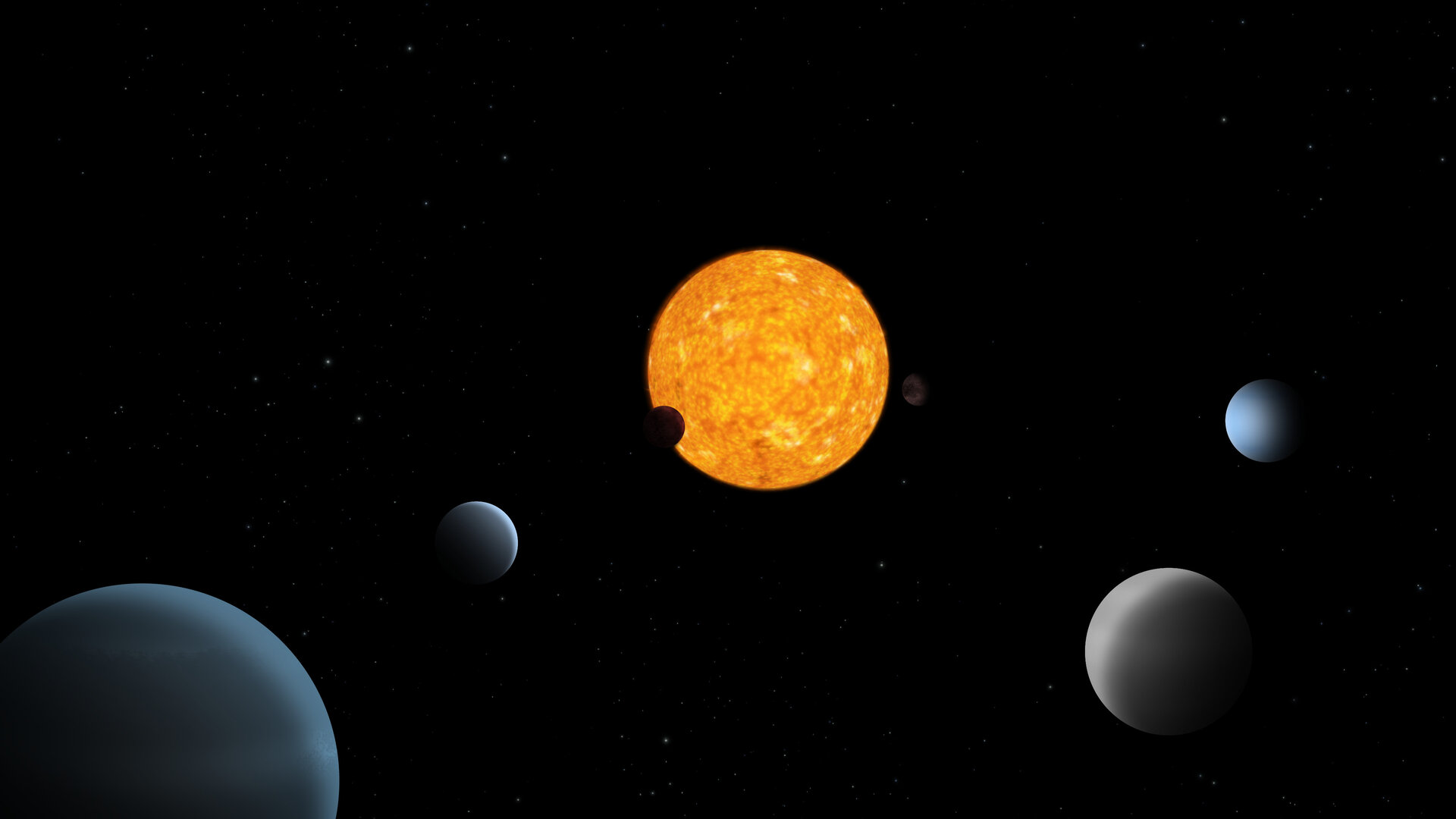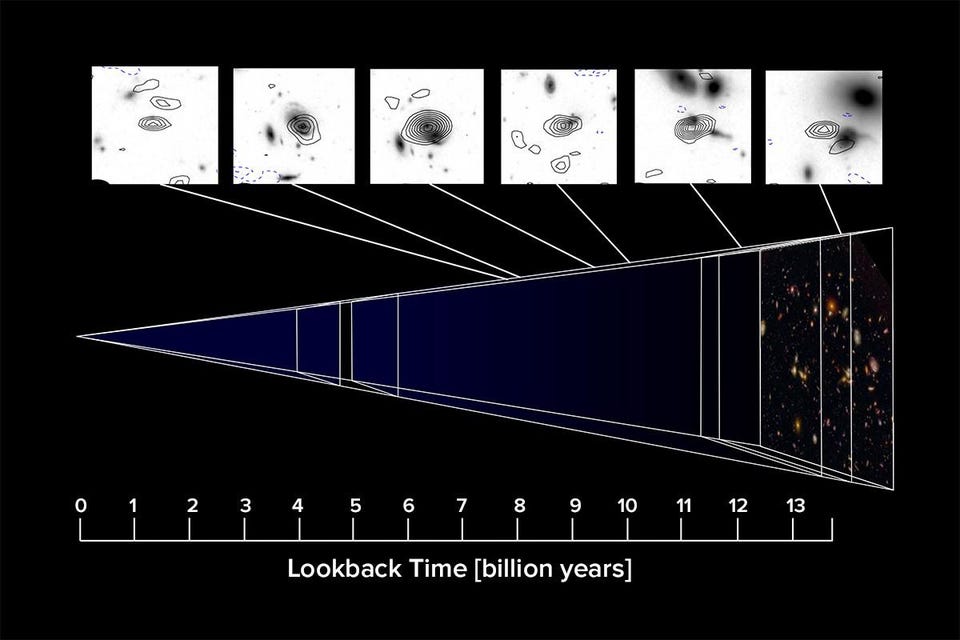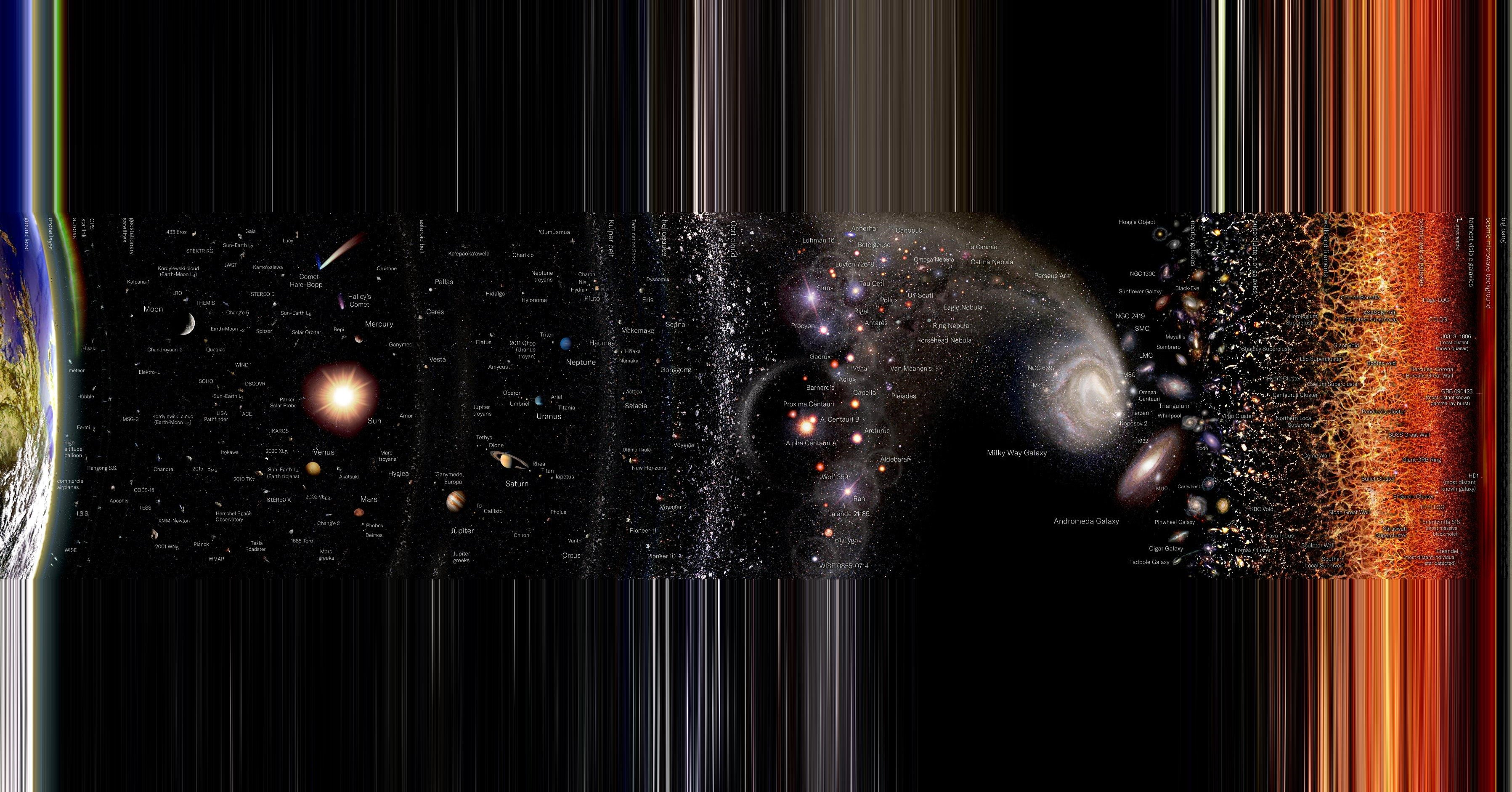What do distant observers see when they look at Earth?
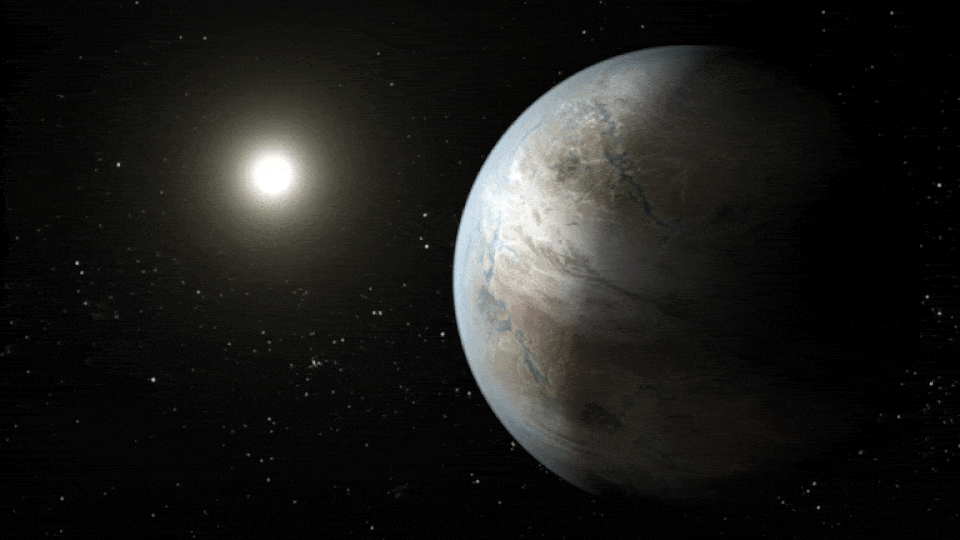
- We can only see objects from across the Universe as they were when the most-recently-emitted light from them arrives at our eyes and instruments.
- As a result, the more distant an object is from us, the longer it takes that distant light to arrive, meaning we’re seeing it as it was in the past: when that now-arriving light was first emitted.
- If that’s true for us, here on Earth, then it must be true for a distant observer looking at us. If there were someone far away watching our planet, here’s what they would see “right now,” from their perspective.
When you view anything at all in the Universe, you’re not seeing it precisely as it is right now: at the moment you experience seeing it. The speed of light, even though it’s the fastest speed that any signal can travel throughout the Universe, is still finite. No matter how close or distant an object is, you’re only seeing it as it was a particular amount of time ago: at the moment the now-arriving light was emitted from the object you’re observing. The fact that light has to travel through space, from the emitted object to the observer that sees it, explains why there’s a gap that we have to fill in through inference alone.
Every observer in the Universe, so long as they haven’t spent a large amount of time traveling close to the speed of light (or in an extraordinarily large gravitational field, such as just outside a black hole’s event horizon), will perceive “right now” as the same instant in time relative to the Big Bang: 13.8 billion years after that creation event. For nearby objects, the speed of light is great enough that the difference in time between source-and-observer can be neglected in most cases. But the farther away we look, the farther back in time, closer toward the instant of the Big Bang, we see.
This implies that, when a distant observer takes a look at Earth, they’re seeing us as we were in the past. Here’s what someone looking at our planet would conclude.
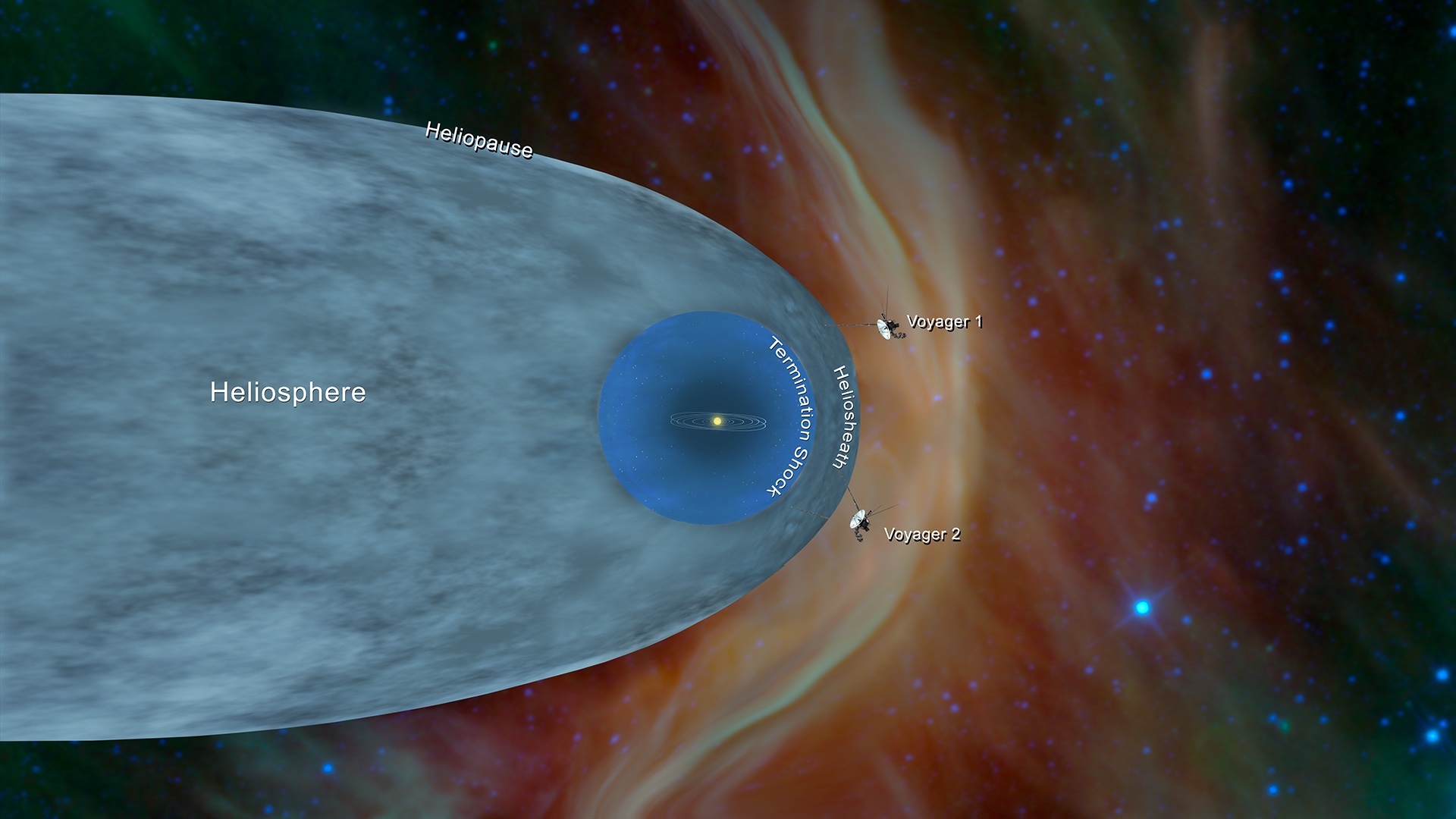
1.) From Voyager 1, our most distant human-made spacecraft.
At present, Voyager 1 is 168.7 astronomical units — or Earth-Sun distances — away from us: corresponding to 14.7 billion miles or 23.5 billion kilometers in more familiar terms. Launched 48 years ago in 1977, it’s taken all these years to get to its present location, which lies beyond the termination shock of our Solar System. It’s one of only 5 spacecraft (6, if you include the gravitational assist that Ulysses will receive in 2098) that are on a trajectory to presently escape from our Solar System, and will remain the most distant one for all-time unless we launch a new mission to overtake it.
And yet, from so far away — farther than any planet, moon, asteroid, or Kuiper belt object within our Solar System — its view of planet Earth is less than a day in the past: it sees us as we were just 23 hours and 23 minutes ago. An observer on the Moon sees us as we were ~1.25 seconds ago; one on Jupiter, presently located 796.4 million kilometers away, sees us as we were ~44 minutes ago; one on Pluto, presently 5.23 billion kilometers away, sees us as we were ~4 hours and 51 minutes ago.
From anywhere in or even nearby our Solar System, the amount someone “looks back” in the past when they look at us is very small, particularly on a cosmic scale. Another, equivalent way to look at this is that even one light-year is a really, really long distance compared to the scale of our Solar System, a distance that Voyager 1 won’t cover until tens of thousands of years have elapsed.

2.) From Sirius, the brightest star in Earth’s night sky.
The stars within our own galaxy are the closest objects known outside of our own Solar System, with every individual star visible with the naked human eye coming from within the Milky Way. The brightest of them all, Sirius, is located 8.6 light-years away, meaning that, to a Sirian, Earth appears as it did in late February of 2017.
Donald Trump has just been sworn in as President of the United States for the first time. Israel announces it will build a new settlement in the West Bank for the first time in 20 years, a move widely deemed to be illegal under international law. A large fire in the Philippines capital, Manila, leaves over 10,000 people homeless. Adele wins Record of the Year and Song of the Year at the Grammy Awards, while Chance the Rapper wins Best New Artist. Frank-Walter Steinmeier gets elected as the President of Germany. And the restart of the Iditarod, for just the third time in the race’s history, is moved to Fairbanks due to poor, low-snow conditions in the Alaska Range.
And, although it’s temporary, the atmospheric carbon dioxide level still dips below 400 parts-per-million during the winter months. A sufficiently advanced alien civilization around Sirius could listen to our cultural products, detect our climate-and-weather patterns, decode our broadcasts, and determine our level of technological advancement. Two-way communication, if they chose to respond to the signals of our presence, could be established in a mere 17 years.

3.) From TOI 700, the first stellar system with an Earth-sized exoplanet discovered in its habitable zone.
It just so happens that TOI 700, presently known to host at least 3 (and maybe 4) exoplanets, is located 101.6 light-years away from Earth. The innermost planet is rocky, the second planet is likely a smaller, warmer version of Neptune, and the third exoplanet from its parent star, TOI 700d, is about 70% more massive and 19% larger in radius than Earth. (If TOI 700 e is real, it’s also rocky, and interior to TOI 700d, changing its status to the 4th exoplanet from its parent star.)
On this world, Earth appears as it does just after the start of the new year of 1924. The very first radio broadcasts from our planet are just arriving in the TOI 700 system, beginning with station 8MK from Detroit, Michigan. The CO2 levels in Earth’s atmosphere have barely crested the 300 parts-per-million level, sitting at 303. The beginning of the transformation of our atmosphere from industrial activity would be detectable from this exoplanet. 85% of Earth’s surface is still wilderness; only 15% has been modified by human activity, largely for food production. Earth is definitely inhabited, and the first signatures that a technologically advanced species lives upon it are appearing. A round-trip message would take more than 2 centuries; in a single human lifetime, you’d never live to hear a response to any message that was sent and received.
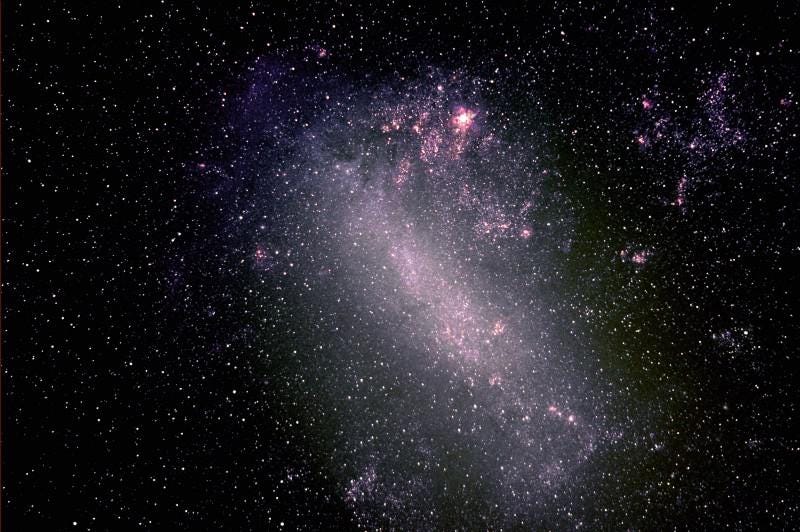
4.) From the Large Magellanic Cloud, the closest intact galaxy beyond the Milky Way.
Once we go beyond the stars in our own galaxy, we’re talking about much longer distances and much farther lookback times. The Large Magellanic Cloud has about 10 billion stars in it, and although the full extent of its stars spans about 32,000 light-years across, it’s an impressive 160,000 light-years away. From the perspective of this galaxy, the Milky Way would look vast and impressive, taking up 30-to-60 degrees in the sky, depending on how faint your skies and how good your eyes can get.
An observer looking at Earth would see our planet as it was 160,000 years ago. Homo sapiens had already evolved, but weren’t the only members of our genus on the planet, as our direct ancestors were joined by the neanderthals, the denisovians, and possibly by the final surviving members of Homo erectus. Our planet would be rich with signs of life, including complex and differentiated life, but the planet was completely in a pre-technological state. Earth was nearly 80,000 years into a long-duration ice age: the penultimate ice age before the rise of human civilization. From an outside perspective in the Large Magellanic Cloud, there’s no known way that the presence of intelligence on Earth could have been identified.
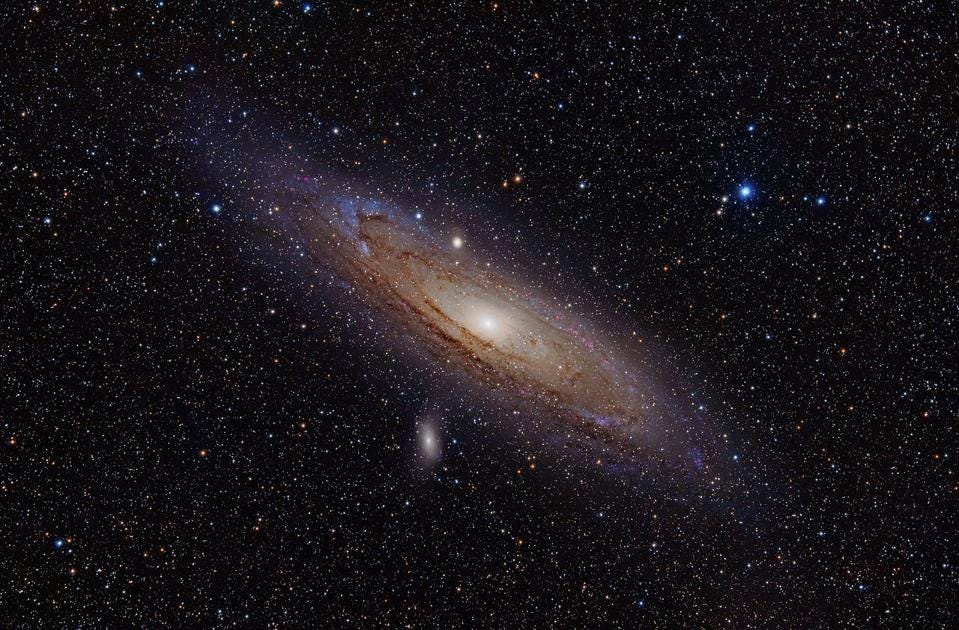
5.) From the Andromeda galaxy, the largest galaxy within the Local Group.
Now we’re really talking about someone looking at our planet as it was a long time ago. Andromeda lies approximately 2.5 million light-years away: the only galaxy in the Local Group more massive and with more stars than our own Milky Way. Someone present in Andromeda right now would see our planet as it was 2.5 million years ago: long before the emergence of modern humans.
In fact, an Andromedean would be able to see the very dawn of the Paleolithic era: where human ancestors first began using Stone Age tools. In addition to fires caused by heat, lightning strikes, and volcanic eruptions, there would be fires at night started by our hominid ancestors: the first members of the genus Homo but prior to the emergence of Homo habilis. For more than a million years, our ancestors lived alongside members of the genus Australopithecus on the African continent exclusively: the only places these unique, controlled, small-scale “night fires” would occur. Giant, long-lasting eruptions occurred during this time on Earth, including Mount Kenya, Little Barrier Island, Norfolk Island, and Boring Lava Field, launching hundreds or even thousands of cubic kilometers of ejecta into the atmosphere: comparable to the Yellowstone Caldera or the great eruption of Lake Toba.
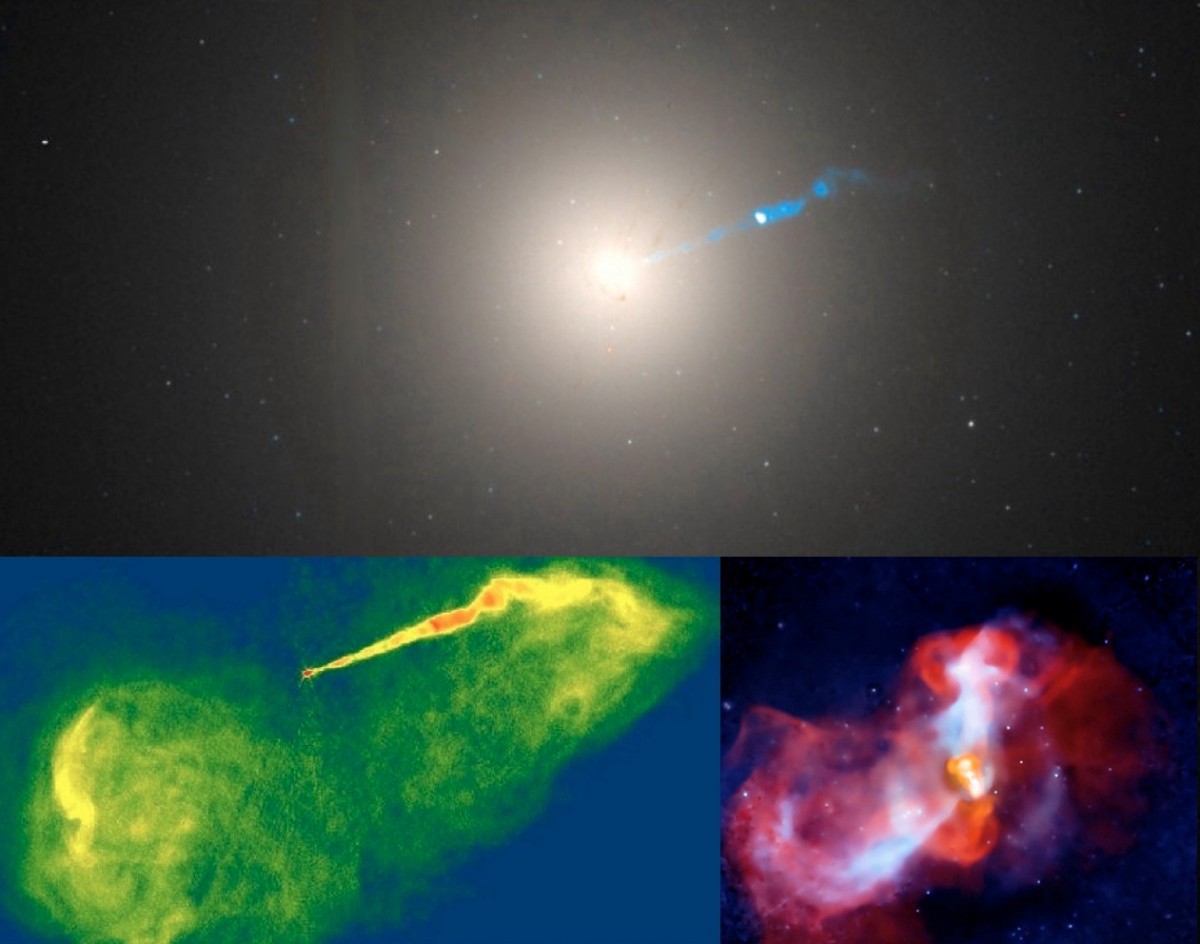
6.) From Messier 87, the most massive galaxy at the center of the nearest (Virgo) cluster of galaxies.
Now we’re really getting somewhere distant. Some 55-60 million light-years away lies the center of the Virgo cluster of galaxies. With about 1000 times the mass of the Milky Way, it’s the closest enormous collection of galaxies in the Universe relative to our location. The very first black hole ever directly imaged was at the center of the giant elliptical galaxy, Messier 87, which sits at the heart of this galaxy cluster. The light we observe from it comes from ~55-60 million years ago, and hence, an observer there would see Earth as it was that amount of time ago.
Planet Earth, as viewed during this time, is well into a period of recovery from a fantastic mass extinction event: the giant Chicxulub impact that led to the Cretaceous–Paleogene extinction event, which occurred 5-10 million years previously. Almost all of the largest plant and animal species on Earth were driven to extinction, including all of the non-avian dinosaurs and the last of the flying reptiles. Mammals, small creatures previously, began to rapidly grow, with the Eohippus, ancestor of the horse, first emerging during this time. Small carnivores like Ankalagon and the tree-climbing Chriacus dominated the land: early examples of hoofed mammals. Marsupials and placental mammals evolved alongside one another, as a separated Pangaea began to split the great, ancient superocean into two separate waters divided by the Americas.
Earth would clearly show itself as a living, inhabited world, albeit one very different in both land masses and atmospheric composition than the one we recognize. Saturn, a signpost in our Solar System, would have possessed larger and more massive rings than we see today.
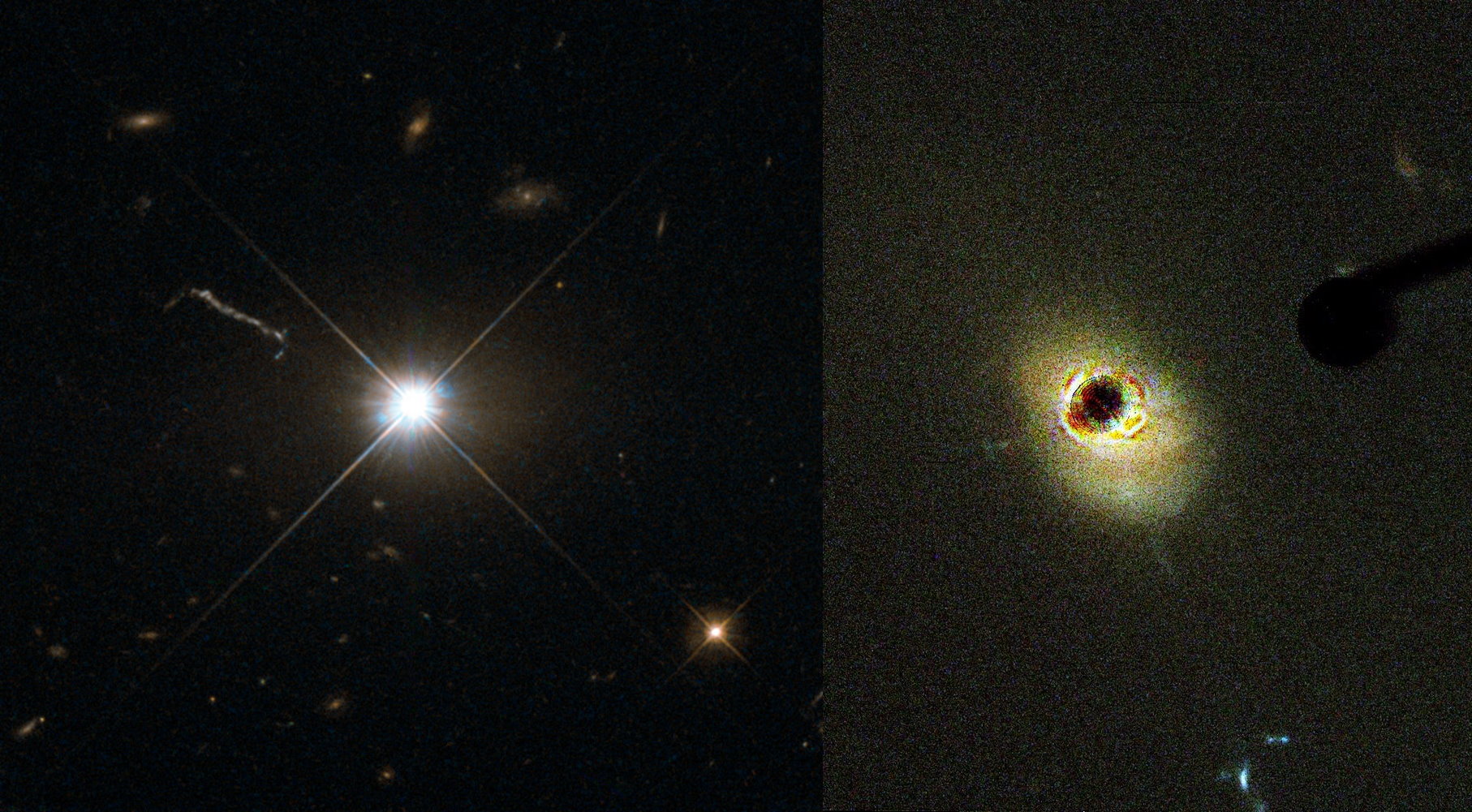
7.) From 3C 273, the first quasar ever found and also the brightest quasar in our night sky.
Now, we’re starting to encounter truly large cosmic distances. 3C 273 was the first quasar ever seen — a QUAsi-StellAr-Radio source — and we now know that this object is an active supermassive black hole at the center of a distant galaxy. Although it’s located more than 2 billion light-years from us, the light we see from it has only been in transit for 1.99 billion years, as the expansion of the Universe has stretched the space between ourselves and this far-flung galaxy while the light completes its journey.
Someone observing the Milky Way from such a great distance, if they could somehow manage to make out our planet, would see Earth as it was nearly 2 billion years ago. After recovering from the great Huronian glaciation, which lasted 300 million years but ended 2.2 billion years ago, the oxygen levels on Earth began to rise to the few-percent level for the first time. Eukaryotes begin to emerge on Earth, with cells now containing enclosed, separated organelles to carry out individual functions within a cell. Photosynthetic organisms like cyanobacteria and blue-green algae persist, while carbon dioxide levels drop to just a few percent. Earth’s early atmosphere, rich in methane and ammonia, is now gone entirely.
Planet Earth is definitely alive, as an atmospheric analysis would reveal, but signs of complex, differentiated, or intelligent life is non-existent. Earth is just another world with successful, but ultimately simple, forms of life. Saturn, meanwhile, would have been ringless like the other giant planets: a condition that would persist for the next ~1.8 billion years.

8.) From galaxy 3C 295, the last galaxy to hold the record (1960-1964) for “most distant object known” until galaxies re-took the record from quasars in 1997.
In 1960, the galaxy 3C 295 was discovered. Appearing to recede from us at about 35% the speed of light, it’s presently located about 5.6 billion light-years away, with the light arriving now having been emitted 4.5 billion years ago.
In some young star cluster within the Milky Way galaxy, about 27,000 light-years from the galactic center, a new star system has just emerged within the last 60 million years. The young, cool star is orbited by four inner planets, one of which has just formed a large moon in the aftermath of a giant impact, followed by an asteroid belt, four gas giants, a Kuiper belt, and an Oort cloud. Pluto is only the second largest member of the Kuiper belt, as it’s dwarfed by Triton, a world that will someday be captured by Neptune.
Planet Earth, this early on, likely has a volatile early atmosphere, dominated by hydrogen, helium, water vapor, ammonia, and methane. So, very likely, did Mars and Venus. Life might already be emerging on any or all of these young worlds, but an external observer would have no identifiable signatures to look for. Until biological activity begins transforming the atmosphere, surface, or waters of this world in a measurable way, it will look like any other rocky planet in the Universe: unremarkable and uninhabited. Someone watching Earth from this vantage point would have no way of predicting that intelligent life would someday emerge on this water-rich world.
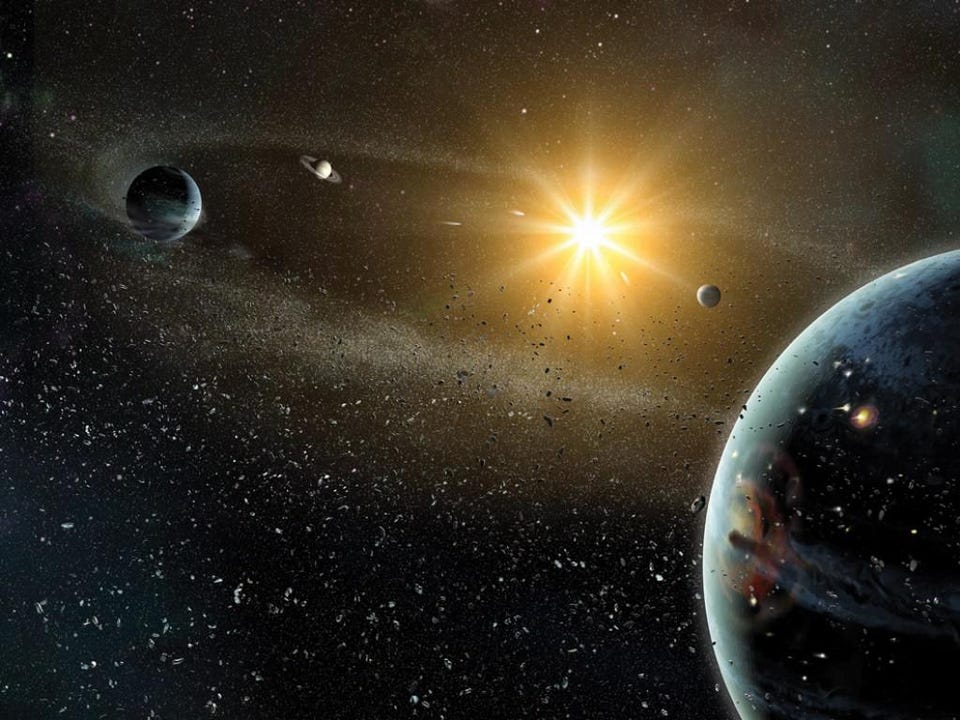
And that’s it. We can’t ask what a more distant observer would see when they looked at planet Earth because a more distant observer wouldn’t be able to see planet Earth. In fact, anyone looking at the Milky Way from farther away than this amount would note that our planet, parent star, and entire Solar System had not yet formed. Given that it’s 46 billion light-years to the edge of the observable Universe, that means that only 0.18% of the stars and galaxies that exist today, within the entire volume of our observable Universe, could even see the Milky Way at a time when planet Earth had been created. Of the some ~20 trillion galaxies within the observable Universe, a whopping 19.962 trillion of them would have no way of even knowing that our home world existed.
Human beings, the only intelligent, advanced civilization known to us, have only been around for a couple of hundred thousand years. Only the few thousand nearest star systems would know that we’ve become technologically advanced; only a civilization within our home galaxy or slightly outside of it would even know of the existence of Homo sapiens. And yet, despite the brevity of our collective existence, we’ve been able to explore, probe, and observe huge swaths of the Universe going all the way back to the earliest moments of the hot Big Bang. For a lonely species on a pale blue dot amidst the great cosmic ocean, that’s perhaps our greatest achievement of all.
This article was first published in September of 2022. It was updated in October of 2025.

